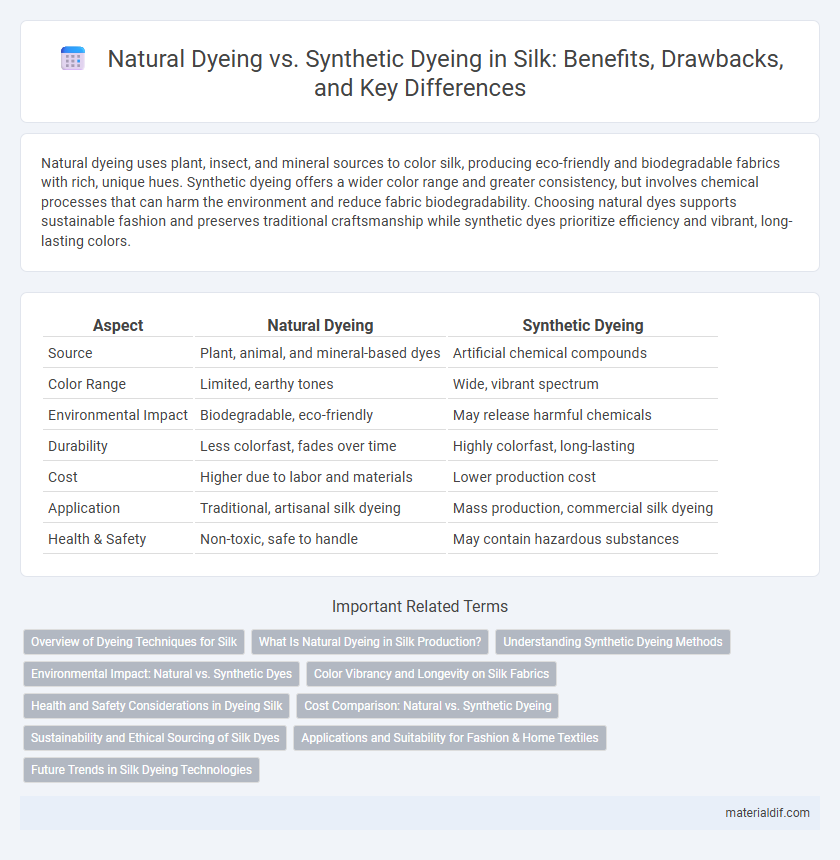Natural dyeing uses plant, insect, and mineral sources to color silk, producing eco-friendly and biodegradable fabrics with rich, unique hues. Synthetic dyeing offers a wider color range and greater consistency, but involves chemical processes that can harm the environment and reduce fabric biodegradability. Choosing natural dyes supports sustainable fashion and preserves traditional craftsmanship while synthetic dyes prioritize efficiency and vibrant, long-lasting colors.
Table of Comparison
| Aspect | Natural Dyeing | Synthetic Dyeing |
|---|---|---|
| Source | Plant, animal, and mineral-based dyes | Artificial chemical compounds |
| Color Range | Limited, earthy tones | Wide, vibrant spectrum |
| Environmental Impact | Biodegradable, eco-friendly | May release harmful chemicals |
| Durability | Less colorfast, fades over time | Highly colorfast, long-lasting |
| Cost | Higher due to labor and materials | Lower production cost |
| Application | Traditional, artisanal silk dyeing | Mass production, commercial silk dyeing |
| Health & Safety | Non-toxic, safe to handle | May contain hazardous substances |
Overview of Dyeing Techniques for Silk
Natural dyeing of silk employs plant-based colorants such as indigo, madder, and cochineal, offering rich, biodegradable hues with subtle variations. Synthetic dyeing uses chemically produced dyes like acid dyes and reactive dyes, ensuring vibrant, consistent colors with superior fastness and large-scale industrial efficiency. Both techniques require precise control of temperature, pH, and mordants to achieve optimal dye absorption and durability on delicate silk fibers.
What Is Natural Dyeing in Silk Production?
Natural dyeing in silk production involves using plant-based materials, minerals, and insects to create vibrant colors without harmful chemicals. This eco-friendly process preserves the silk's luxurious texture and enhances its biodegradability, appealing to sustainable fashion markets. Traditional techniques like indigo, madder root, and cochineal dyes provide unique, non-toxic shades that vary with water quality and temperature during dyeing.
Understanding Synthetic Dyeing Methods
Synthetic dyeing methods for silk involve the use of chemically formulated dyes designed to produce vibrant, consistent colors with high colorfastness. These dyes often include acid dyes, reactive dyes, and disperse dyes, each tailored to bond effectively with silk fibers through specific chemical reactions. Understanding the interaction between silk's protein fibers and synthetic dye molecules is crucial for achieving desired hues while minimizing environmental impact and enhancing dye uptake efficiency.
Environmental Impact: Natural vs. Synthetic Dyes
Natural dyes derived from plants, insects, and minerals are biodegradable and produce minimal toxic waste, making them environmentally friendly for silk dyeing. Synthetic dyes, composed of petrochemicals, often release harmful pollutants and non-biodegradable residues into water systems, contributing significantly to environmental degradation. Choosing natural dyes reduces chemical runoff and supports sustainable silk production, whereas synthetic dyes pose greater risks to ecosystems and human health.
Color Vibrancy and Longevity on Silk Fabrics
Natural dyeing on silk fabrics produces rich, multi-dimensional hues that develop a unique patina over time, enhancing the fabric's tactile and visual appeal. Synthetic dyeing offers highly vibrant and consistent colors with superior colorfastness, ensuring long-lasting hues that resist fading from light and washing. While synthetic dyes provide durability and precision, natural dyes contribute to an eco-friendly process with subtle, evolving color characteristics that appeal to artisanal craftsmanship.
Health and Safety Considerations in Dyeing Silk
Natural dyeing of silk uses plant-based pigments that are typically non-toxic and biodegradable, reducing health risks for workers and environmental impact. Synthetic dyes may contain harmful chemicals and heavy metals, posing potential respiratory and skin hazards during application and requiring careful handling and disposal measures. Ensuring proper ventilation, protective equipment, and eco-friendly dye choices enhances safety in the silk dyeing process.
Cost Comparison: Natural vs. Synthetic Dyeing
Natural dyeing of silk often involves higher costs due to the labor-intensive extraction process and limited availability of raw materials like indigo, madder, or cochineal. Synthetic dyes, derived from petrochemicals, provide a cost-effective alternative with consistent quality and faster processing times, significantly reducing overall production expenses. Despite the initial cost advantage, natural dyes may command higher market prices driven by consumer demand for eco-friendly and artisanal textiles.
Sustainability and Ethical Sourcing of Silk Dyes
Natural dyeing of silk relies on plant, mineral, and insect-based colorants, promoting sustainability through biodegradability and lower chemical impact on the environment. Synthetic dyeing, while offering vibrant and consistent colors, often involves toxic chemicals and non-renewable resources that raise ethical concerns about pollution and worker safety. Prioritizing natural dyes supports ethical sourcing by reducing environmental damage and preserving traditional artisan methods in silk production.
Applications and Suitability for Fashion & Home Textiles
Natural dyeing in silk offers unique, eco-friendly hues ideal for artisanal and luxury fashion collections, as well as home textiles seeking organic aesthetics and sustainability. Synthetic dyeing provides vibrant, consistent colors with high durability, making it suitable for mass-produced fashion and home fabrics requiring colorfastness and uniformity. Fashion designers and textile manufacturers select dyeing methods based on the balance between environmental impact, fabric performance, and market demand.
Future Trends in Silk Dyeing Technologies
Future trends in silk dyeing technologies emphasize sustainable natural dyes derived from plants, insects, and minerals, reducing chemical pollutants and water consumption. Innovations in enzymatic treatment and bio-mordants enhance colorfastness and vibrancy in natural dyeing, making it a competitive alternative to synthetic dyes. Advances in nanotechnology and digital printing enable precise, eco-friendly synthetic dyeing methods that minimize waste and energy use while offering vibrant, customizable color options.
Natural dyeing vs Synthetic dyeing Infographic

 materialdif.com
materialdif.com